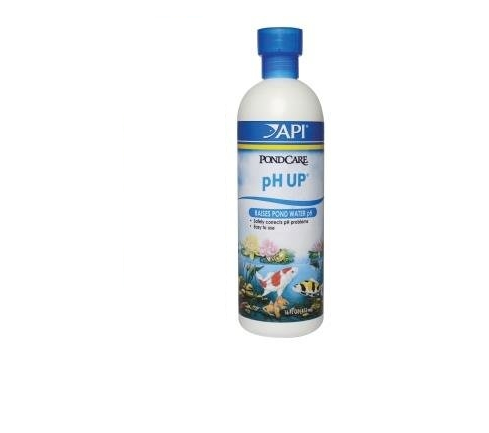
Makes Water More or Less Acidic As Needed!
- Slowly raises pH of pond water, which can changed from day to day
- Will not harm delicate fish or pond plants
- Phosphate-free and does not promote algae growth
Test Water With Wide Range Test Kit Before Adding
pH Up - 16 oz. - pH Up
PondCare's Technical Reference Sheet States:
Purpose And Benefits:
pH is the measure of the acidity in pond water. A pH reading of 7.0 is neutral, a pH higher than 7.0 is alkaline, and lower than 7.0 is acidic. Acid rain, mineral leaching, soil runoff and decomposing plant and fish waste can alter the pH and cause unacceptable levels. Some sources of tap water used to fill ponds can also cause extreme pH levels. A pH below 6.8 or above 8.0 should be avoided. A pH level of 7.0 to 7.5 is ideal. pH levels of less than 6.8 can stress pond fish and suppress the activity of the biological filter. A high pH of more than 8.0 will limit the ability of many plants to absorb necessary nutrients.
Pond Care pH Up will increase the pH in garden ponds by neutralizing excess acid. This product can be used daily to adjust pH until conditions stabilize. pH Up contains no algae-promoting phosphates. It is important to accurately measure the level of pH in a pond before initiating adjustments. Use a PondCare pH Test Kit to measure your pH weekly.
pH should be either raised or lowered by no more than 0.5 units every 24 hours. Do not treat pond water more than once every 24 hours. Plants and algae cause a temporary increase in pH in the afternoon. Therefore, pH should be tested in the early morning to obtain the most accurate reading.
Pond Care pH Up will increase the pH in garden ponds by neutralizing excess acid. This product can be used daily to adjust pH until conditions stabilize. pH Up contains no algae-promoting phosphates. It is important to accurately measure the level of pH in a pond before initiating adjustments. Use a PondCare pH Test Kit to measure your pH weekly.
pH should be either raised or lowered by no more than 0.5 units every 24 hours. Do not treat pond water more than once every 24 hours. Plants and algae cause a temporary increase in pH in the afternoon. Therefore, pH should be tested in the early morning to obtain the most accurate reading.
Directions For Use:
Carefully mix desired dose with 2 U.S. gallons of pond water in a plastic bucket and distribute evenly around the perimeter of the pond.
1. Test the pH of the pond water with a PondCare Liquid Wide Range pH Test Kit.
2. Add 2 teaspoonfuls for every 50 U.S. gallons (189 L) of pond water
3. Wait 24 hours, then test pH. Repeat treatment as necessary.
1. Test the pH of the pond water with a PondCare Liquid Wide Range pH Test Kit.
2. Add 2 teaspoonfuls for every 50 U.S. gallons (189 L) of pond water
3. Wait 24 hours, then test pH. Repeat treatment as necessary.
Questions & Answers
Have a Question?
Be the first to ask a question about this.
Recommended for the API® POND pH Up®
Product title
Vendor
$19.99 | $24.99
Product title
Vendor
$19.99 | $24.99
Product title
Vendor
$19.99 | $24.99
Product title
Vendor
